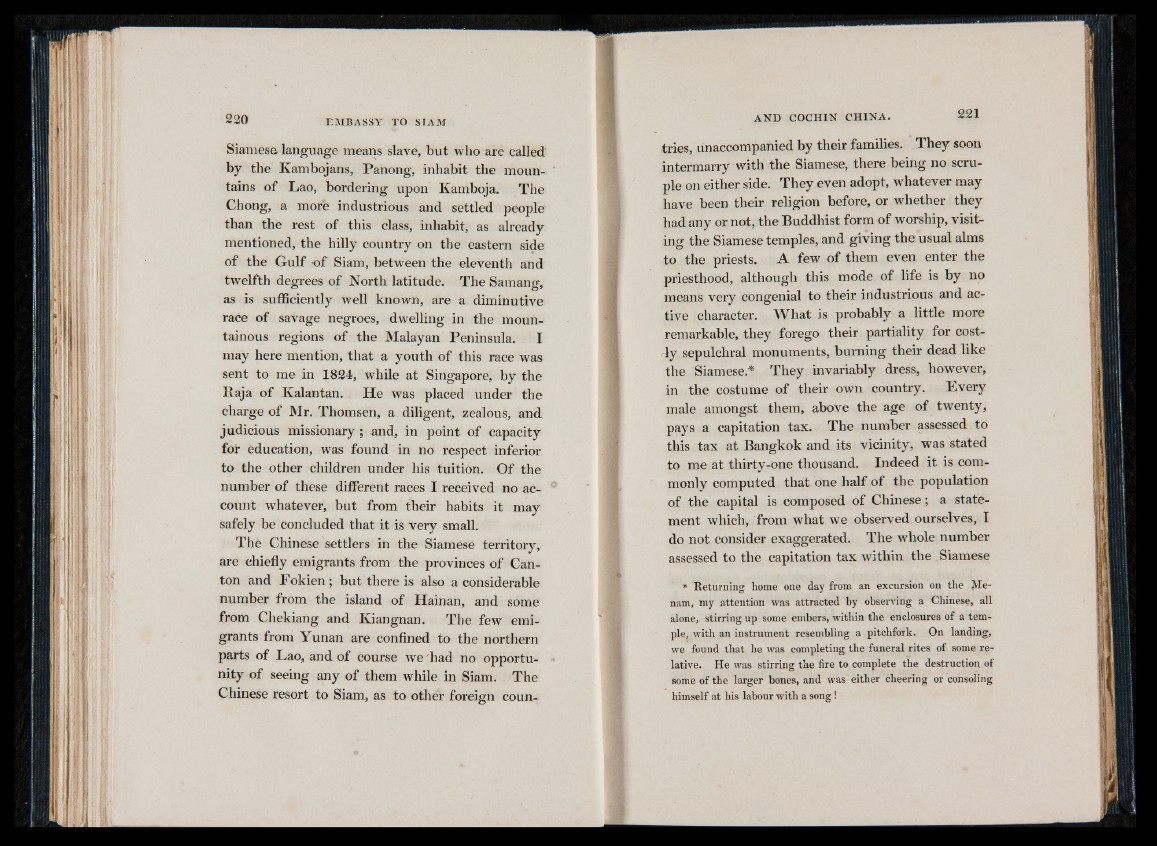
Siamese language means slave, but who are called
by the Kambojans, Panong, inhabit the moun- '
tains of Lao, bordering upon Kamboja. The
Chong, a more industrious and settled people
than the rest of this class, inhabit, as already
mentioned, the hilly country on the eastern side
of the Gulf o f Siam, between the eleventh and
twelfth degrees of North latitude.0 The Samaneor.’
as is sufficiently well known, are a diminutive
race of savage negroes, dwelling in the mountainous
regions of the Malayan Peninsula. I
may here mention, that a youth of this race was
sent to me in 1824, while at Singapore, by the
Raja of Kalantan. He was placed under the
charge of Mr. Thomsen, a diligent, zealous, and
judicious missionary; and, in point of capacity
for education, was found in no respect inferior
to the other children under his tuition. Of the
number of these different races I received no account
whatever, but from their habits it may
safely be concluded that it is very small.
The Chinese settlers in the Siamese territory,
are chiefly emigrants from the provinces of Canton
and Fokien; but there is also a considerable
number from the island of Hainan, and some
from Chekiang and Kiangnan. The few emigrants
from Yunan are confined to the northern
parts of Lao, and of course we 'had no opportunity
of seeing any of them while in Siam. The
Chinese resort to Siam, as to other foreign countries,
unaccompanied by their families. They soon
intermarry with the Siamese, there being no scruple
on either side. They even adopt, whatever may
have been their religion before, or whether they
had any or not, the Buddhist form of worship, visiting
the Siamese temples, and giving the usual alms
to the priests. A few of them even enter the
priesthood, although this mode of life is by no
means very congenial to their industrious and active
character. What is probably a little more
remarkable, they forego their partiality for cost-
dy sepulchral monuments, burning their dead like
the Siamese.* They invariably dress, however,
in the costume of their own country. Every
male amongst them, above the age of twenty,
pays a capitation tax. The number assessed to
this tax at Bangkok and its vicinity, was stated
to me at thirty-one thousand. Indeed it is commonly
computed that one half of the population
of the capital is composed of Chinese; a statement
which, from what we observed ourselves, I
do not consider exaggerated. The whole number
assessed to the capitation tax within the Siamese
* Returning home one day from an excursion on the Me-
nam, my attention was attracted by observing a Chinese, all
alone, stirring up some embers, within the enclosures of a temple,
with an instrument resembling a pitchfork. On landing,
we found that he was completing the funeral rites of some relative.
He was stirring the fire to complete the destruction, of
some of the larger bones, and was either cheering or consoling
himself at his labour with a song!